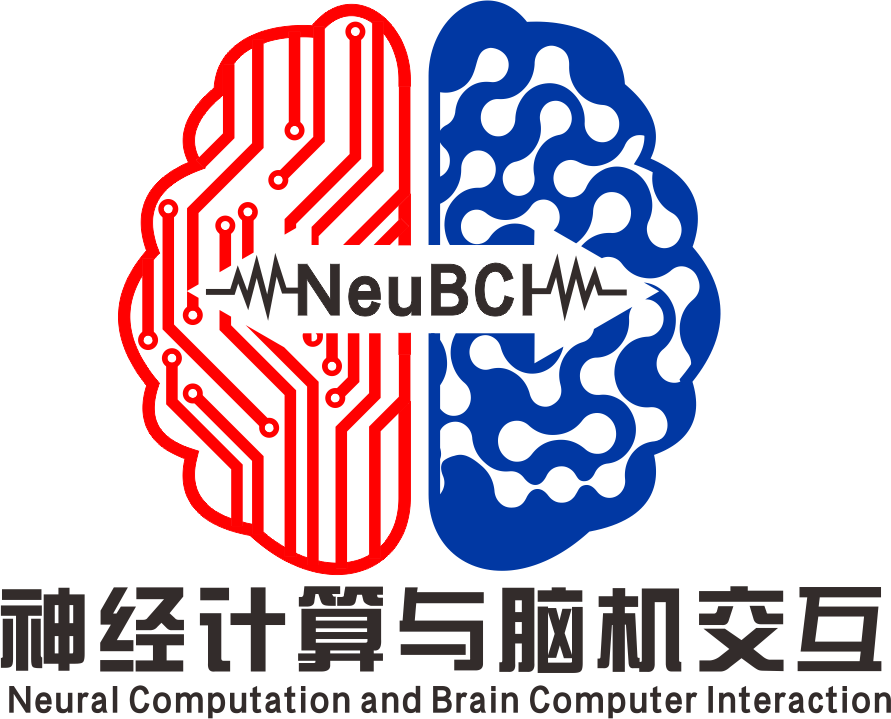表于IEEE Engineering in Medicine & Biology Society (EMBS)的四篇文章信息如下:
文章一:Temporal Dynamics on Decoding Target Stimuli in Rapid Serial Visual Presentation using Magnetoencephalography
作者:Chuncheng Zhang,Shuang Qiu,Shengpei Wang,Wei Wei,Huiguang He
中文摘要:
研究背景: 快速序列视觉呈现(RSVP)是一种高效的脑机接口(BCI)实验范式。 如何高效的识别出目标刺激是基于 RSVP 的脑机接口实验的关键。 目前,在如何选择最优的信号频率与时间段,以及目标刺激所诱发的信号具有怎样的时间动态性特征,仍然未有定论,值得进行深入研究。
研究内容及方法: 我们进行了基于脑磁图(MEG)数据的 RSVP 实验,本文针对目标刺激所诱发的信号的时间动态性和频谱特性进行了深入考察:
1.使用多变量模式分析(MVPA)方法,分别使用多频段的 MEG 数据进行 RSVP 目标识别,并且通过时间窗分析找出最优的目标识别时间段
2.结合与 MEG 数据成对的磁共振(MRI)数据,对 MEG 信号进行源定位分析,对相关的神经机制进行了一定程度的解析。
研究结果: MVPA 分析结果表明,MEG 信号中较低频的成分(0.1 到 7 赫兹)对应最高的分类正确率和目标检出率,说明该频率成分可以用于对 RSVP 目标进行识别,并且时间窗分析结果表明,在目标出现后 0.4 秒时,识别正确率和目标检出率达到最高值。 源定位分析结果表明,RSVP 目标识别任务中,MEG 信号反映的目标刺激所诱发的脑活动具有较强的分区特性,主要激活的脑区有双侧海马旁回,中央前回及岛叶等。
英文摘要(原文):
Rapid serial visual presentation (RSVP) is a high efficient paradigm in brain-computer interface (BCI). Target detection accuracy is the first consideration of RSVP-BCI. But the influence of different frequency bands and time ranges on decoding accuracy are still an open questions. Moreover, the underlying neural dynamic of the rapid target detecting process is still unclear. Methods: This work focused the temporal dynamic of the responses triggered by target stimuli in a static RSVP paradigm using paired structural Magnetic Resonance Imaging (MRI) and magnetoencephalography (MEG) signals with different frequency bands. Multivariate pattern analysis (MVPA) was applied on the MEG signal with different frequency bands and time points after stimuli onset. Cortical neuronal activation estimation technology was also applied to present the temporal-spatial dynamic on cortex surface. Results: The MVPA results showed that the low frequency signals (0.1 – 7 Hz) yield highest decoding accuracy, and the decoding power reached its peak at 0.4 second after target stimuli onset. The cortical neuronal activation method identified the target stimuli triggered regions, like bilateral parahippocampal cortex, precentral gyrus and insula cortex, and the averaged time series were presented.
文章二:A CNN-based compare network for classification of SSVEPs in human walking
作者:Chenyao Wu,Shuang Qiu,Jiezhen Xing,Huiguang He
中文摘要:
脑机接口(BCI)可以为残疾人提供一种与外界互动的方式。稳态视觉诱发电位(SSVEP)是一种重要的BCI范式,它通过视觉刺激来诱发电位。在实验室环境下,SSVEPs的分类准确率很高。然而,在运动状态下,准确率会受到很大的影响,并且降低很多。在这篇文章中,为了提高运动状态下SSVEP信号的分类准确率,我们采集了0km/h、2.5km/h和5km/h三种速度下,5个目标的SSVEP数据。并且提出了一种基于卷积神经网络(CNN)的比较网络,比较网络通过学习EEG信号与模板之间的关系来分类,模板对应于每一个刺激频率。将我们的方法与传统方法(CCA、FBCCA和支持向量机)和最新方法(CNN)分别应用于20名被试的SSVEP数据集上,并进行比较。我们提出的方法在不同速度下的表现都是最好的。因此,这些结果验证了该方法的有效性。此外,与0公里/小时的速度相比,在较高的步速(5公里/小时)下,比较网络的准确率并没有降低多少,仍然可以保持良好的性能。
英文摘要:
Brain-computer interface (BCI) can provide a way for the disabled to interact with the outside world. Steady-state visual evoked potential (SSVEP), which evokes potential through visual stimulation is one of important BCI paradigms. In laboratory environment, the classification accuracy of SSVEPs is excellent. However, in motion state, the accuracy will be greatly affected and reduce quite a lot. In this paper, in order to improve the classification accuracy of the SSVEP signals in the motion state, we collected SSVEP data of five targets at three speeds of 0km/h, 2.5km/h and 5km/h. A compare network based on convolutional neural network (CNN) was proposed to learn the relationship between EEG signal and the template corresponding to each stimulus frequency and classify. Compared with traditional methods (i.e., CCA, FBCCA and SVM) and state-of-the-art method (CNN) on the collected SSVEP datasets of 20 subjects, the method we proposed always performed best at different speeds. Therefore, these results validated the effectiveness of the method. In addition, compared with the speed of 0 km / h, the accuracy of the compare network at a high walking rate (5km/h) did not decrease much, and it could still maintain a good performance.
文章三:A Transfer Learning Framework for RSVP-based Brain Computer Interface
作者:Wei Wei,Shuang Qiu,Xuelin Ma,Dan Li,Chuncheng Zhang,Huiguang He
中文摘要:
基于快速序列视觉呈现(RSVP)的脑-机接口(BCI)是一种有效的信息检测技术,它通过检测目标视觉刺激诱发的事件相关的脑反应来实现对视觉目标的自动检测。但在新用户使用该系统之前,需要一个耗时的校准过程。因此,减少BCI应用的校准工作是很重要的。本文中,我们采集了一个基于RSVP的脑电(EEG)数据集,包括11名受试者,实验任务是图像检索。我们提出了一个多源迁移学习框架,利用其他被试的数据来减少新被试模型训练对校准数据的需求。首先采用源选择策略避免负迁移,然后,提出了一种基于领域对抗训练的迁移学习网络。在模型中,基于卷积神经网络(CNN)的特征提取器用于从不同的被试中提取脑电数据的共同特征,而鉴别器则试图区分提取的不同被试的特征。此外,还增加了一个分类器来学习类别语义信息。为了使对抗网络能够稳定训练并提高性能,我们加入条件信息和梯度惩罚项。实验结果表明,我们提出的迁移学习框架优于一系列最新的和基线方法。
英文摘要:
Rapid Serial Visual Presentation (RSVP)-based Brain-Computer Interface (BCI) is an efficient information detection technology by detecting event-related brain responses evoked by target visual stimuli. However, a time-consuming calibration procedure is needed before a new user can use this system. Thus, it is important to reduce calibration efforts for BCI applications. In this paper, we collect an RSVP-based electroencephalogram (EEG) dataset, which includes 11 subjects. The experimental task is image retrieval. Also, we propose a multi-source transfer learning framework by utilizing data from other subjects to reduce the data requirement on the new subject for training the model. A source-selection strategy is firstly adopted to avoid negative transfer. And then, we propose a transfer learning network based on domain adversarial training. The convolutional neural network (CNN)-based network is designed to extract common features of EEG data from different subjects, while the discriminator tries to distinguish features from different subjects. In addition, a classifier is added for learning semantic information. Also, conditional information and gradient penalty are added to enable stable training of the adversarial network and improve performance. The experimental results demonstrate that our proposed method outperforms a series of state-of-the-art and baseline approaches.
文章四:Changes of resting-state EEG microstates induced by low-frequency repetitive transcranial magnetic stimulation
作者:Shuang Qiu,Shengpei Wang,Weibo Yi,Chuncheng Zhang,Huiguang He
中文摘要:
重复经颅磁刺激(rTMS)是一种非侵入性脑刺激技术,可以影响皮层兴奋性。低频rTMS(刺激频率≤1Hz)对皮层兴奋性具有长期抑制作用。同时,已有相关脑电微状态的研究表明,其与大脑功能相关。为了研究低频rTMS后脑电图微状态的动态变化,本研究募集20名健康受试者,在右侧运动区接受1-Hz rTMS,并在rTMS(Pre)之前记录了处于静止状态且睁眼的脑电数据(EEG)。在rTMS之后的0分钟,20分钟,40分钟和60分钟(Post0,Post20,Post40和Post60)采集脑电数据。使用聚类算法计算所有五个时间点的EEG数据,发现了四个EEG微状态,并用字母A,B,C和D标记。在五个时间段中,发现微状态的持续时间没有发现显着差异。对于微状态A和B,在rTMS之后立即增加平均持续时间。对于微状态C,Post0和Post60的平均持续时间显着高于rTMS之前的平均持续时间。对于微状态D,rTMS后60分钟的平均持续时间增加。这些结果表明,我们重现了相同的四个大脑微状态,其最能代表其他人发现的静息状态EEG,而低频rTMS在EEG微状态的平均持续时间内产生了持久的变化。这意味着低频rTMS可以提高EEG微状态的稳定性。
英文摘要:
Repetitive Transcranial magnetic stimulation (rTMS) is a noninvasive brain stimulation technique that able to influence cortical excitability. Low-frequency rTMS (stimulation frequency ≤1Hz) induces long-lasting inhibitory effects on cortical excitability. At the same time, EEG microstates have been studied and have been thought to corresponding to functional relevant brain-states. In order to investigate dynamic changes in EEG microstates after low-frequency rTMS, 20 healthy subjects received 1-Hz rTMS over the right motor area, and electroencephalography (EEG) in resting condition with eyes open was recorded before rTMS (Pre) and at 0 min, 20 min, 40 min, and 60 min after rTMS (Post0, Post20, Post40, and Post60). Resting state EEG data of all five sessions were computed using a clustering algorithm. Four EEG microstates were found and labeled with the letters A, B, C and D. No significant difference in duration was found for four microstates. For microstates A, and B, there is an increase in the mean duration immediately after rTMS. And for microstate C, the mean duration at Post0 and Post60 was significantly higher than that before rTMS. For microstate D, there is an increase in the mean duration at 60min after rTMS. These results showed that we reproduced the same four microstate maps best representing the resting state EEG as found by others and hat low-frequency rTMS produced long-lasting alterations in the mean duration of EEG microstates. It implies that low-frequency rTMS increases the stability of EEG microstates.
